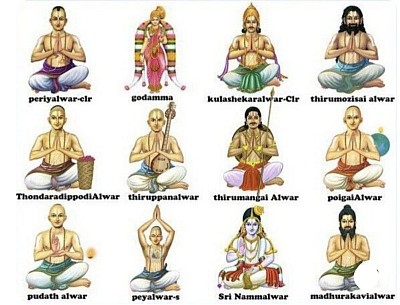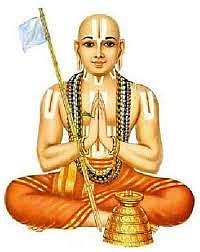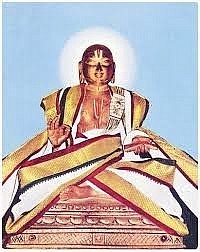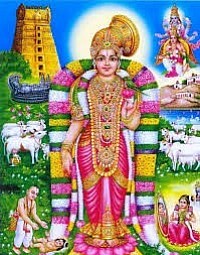Baghavadha Sampradhayam
Twelve Azwargal
The "Alzwargal" refers to the Azhwars (also spelled Alvars), who are revered as the twelve poet-saints of South Indian Vaishnavism. The Azhwars were ardent devotees of Lord Vishnu and composed devotional hymns in Tamil, which are compiled in the "Nalayira Divya Prabandham," a collection of 4,000 verses. They played a significant role in spreading the Bhakti movement and revitalizing Vaishnavism in South India during the early medieval period.
The Twelve Azhwars
Poigai Azhwar
Era: 7th century CE Background: Born in Kanchipuram, Poigai Azhwar is often considered the first of the Azhwars. His hymns express deep devotion to Lord Vishnu, emphasizing the significance of surrender and grace. Notable Work: "Mudhal Tiruvandhadhi" (First Decad)
Bhoothath Azhwar
Era: 7th century CE Background: Hailing from Thirukadalmallai (Mahabalipuram), Bhoothath Azhwar emphasized the power of divine love and the need to perceive the Lord everywhere. Notable Work: "Irandaam Tiruvandhadhi" (Second Decad)
Pey Azhwar
Era: 7th century CE Background: Born in Mylapore, Chennai, Pey Azhwar’s hymns are mystical and express the joy of experiencing the divine presence. His works speak of the vision of Lord Vishnu as seen in his divine form. Notable Work: "Moondraam Tiruvandhadhi" (Third Decad)
Thirumalisai Azhwar
Era: 7th-8th century CE Background: Born in Thirumalisai near Kanchipuram, Thirumalisai Azhwar is known for his unwavering devotion and philosophical outlook. He emphasized the transient nature of the world and the eternal nature of God. Notable Work: "Naanmugan Thiruvandhadhi"
Nammalwar
Era: 9th century CE Background: Nammalwar, considered the most prominent among the Azhwars, was born in Alwarthirunagari (Tirunelveli district). His works are deeply philosophical and devotional, focusing on surrender (prapatti) to Lord Vishnu. Notable Work: "Thiruvaimozhi," a revered text often referred to as the Tamil Veda.
Madhurakavi Azhwar
Era: 9th century CE Background: A disciple of Nammalwar, Madhurakavi Azhwar is unique in that his devotion was directed towards his guru, Nammalwar, rather than directly to Lord Vishnu. His hymns reflect his deep reverence for his spiritual guide. Notable Work: "Kanninun Siruthambu"
Kulasekara Azhwar
Era: 9th century CE Background: A king from the Chera dynasty, Kulasekara Azhwar’s devotion led him to renounce his kingdom. His hymns express deep love for Lord Rama and Lord Krishna. Notable Work: "Perumal Thirumozhi"
Periyalwar
Era: 9th century CE Background: Born in Srivilliputhur, Periyalwar was the father of Andal (the only female Azhwar). His works focus on the childhood of Lord Krishna and the joy of divine motherhood. Notable Work: "Periyalwar Thirumozhi"
Andal (Goda Devi)
Era: 9th century CE Background: Andal, the only female Azhwar and daughter of Periyalwar, is revered for her deep love for Lord Vishnu. Her devotional hymns are filled with the longing for union with the divine. Notable Works: "Thiruppavai" and "Nachiyar Thirumozhi"
Thondaradippodi Azhwar
Era: 8th century CE Background: Born in Thirumandangudi, Thondaradippodi Azhwar devoted his life to serving the devotees of Lord Vishnu. His hymns are a combination of devotion and humility. Notable Work: "Thirumalai" and "Thirupalliyezhuchi"
Thiruppaan Azhwar
Era: 8th-9th century CE Background: Hailing from Uraiyur (Tiruchirapalli), Thiruppaan Azhwar was from a lower caste but was revered for his devotion to Lord Ranganatha of Srirangam. His hymns reflect the vision of the Lord from head to foot. Notable Work: "Amalanadhipiran"
Thirumangai Azhwar
Era: 8th century CE
Background: A former chieftain
turned saint, Thirumangai Azhwar composed numerous hymns praising various
Vishnu temples across South India. His works are marked by their poetic
richness and devotion.
Notable Work: "Periya
Thirumozhi"
Legacy and Influence
The Azhwars’ hymns are still sung in Vishnu temples, particularly in the Tamil-speaking regions, and their devotion has greatly influenced Vaishnavism. Their emphasis on surrender, devotion, and divine grace laid the foundation for later Vaishnava movements, such as those led by Ramanuja, a theologian and philosopher who further developed the concept of Vishishtadvaita (qualified non-dualism).
The Azhwars' contributions are celebrated during festivals, particularly in Divya Desams (108 sacred Vishnu temples). Their devotion continues to inspire millions of devotees, and their hymns remain integral to Vaishnava worship practices.
Shri Ramanuja
Shri Ramanuja, also known as Ramanujacharya, was one of the most influential theologians, philosophers, and spiritual leaders in the history of Hinduism. He is renowned for establishing the Vishishtadvaita (qualified non-dualism) school of Vedanta and for his significant role in shaping the devotional (bhakti) movement in South India. His teachings continue to have a profound impact on the Vaishnava tradition and Hinduism as a whole.
Early Life
Birth: Ramanuja was born in 1017 CE in a Brahmin family in Sriperumbudur, near Chennai, Tamil Nadu. Name: His full name was Ilaya Perumal, and he later became known as Ramanuja, which means "the younger brother of Rama." Education: Ramanuja showed great intellectual promise from a young age. He studied under Yadavaprakasha, a prominent Advaita Vedanta teacher, but soon began to disagree with his teacher's interpretations of the scriptures, particularly regarding the impersonal nature of Brahman.
Philosophy: Vishishtadvaita (Qualified Non-Dualism)
Ramanuja's primary philosophical contribution was the establishment of Vishishtadvaita, a school of Vedanta that emphasizes a personal and qualified non-dualistic understanding of the relationship between the individual soul (Jivatma), the universe (Prakriti), and the supreme being (Brahman, identified with Vishnu).
Key concepts of Vishishtadvaita:
Qualified Non-Dualism: While Advaita Vedanta (non-dualism) teaches that the individual soul and Brahman are ultimately identical, Ramanuja argued that the individual soul and Brahman are distinct but inseparably related. Brahman is the supreme, personal God (Vishnu), who possesses both unity and diversity. Saguna Brahman: Ramanuja emphasized that Brahman (Vishnu) is not an abstract, formless entity but a personal God with qualities (saguna). Vishnu is the ultimate reality, full of compassion, grace, and love. Devotion (Bhakti): Ramanuja placed a strong emphasis on devotion to God (bhakti) as the primary means of attaining salvation (moksha). He taught that through sincere devotion, self-surrender (prapatti), and grace, the soul could attain liberation and eternal communion with Vishnu. Sri Vaishnavism: Ramanuja's teachings laid the foundation for the Sri Vaishnava tradition, which venerates Vishnu and his consort, Lakshmi, as the supreme divine couple. He integrated the Tamil devotional hymns of the Azhwars with the Sanskrit scriptures, emphasizing the importance of both Vedic and Tamil traditions in worship.
Major Works
Ramanuja authored several key philosophical and devotional texts that articulate his ideas:
Sri Bhashya: A comprehensive commentary on the Brahma Sutras, in which Ramanuja refutes the interpretations of other Vedantic schools, particularly Advaita Vedanta, and presents his Vishishtadvaita perspective. Gita Bhashya: A commentary on the Bhagavad Gita, where Ramanuja emphasizes the importance of bhakti and devotion to Lord Krishna. Vedarthasangraha: A summary of the essential teachings of the Vedas, where Ramanuja highlights the compatibility of the Vedic texts with his philosophy of Vishishtadvaita. Nithya Grantham: A manual for daily worship and rituals.
Reforms and Legacy
Ramanuja was not just a philosopher but also a social reformer and spiritual leader who worked tirelessly to make religious practices more inclusive. Some of his notable contributions include:
Social Reform: Ramanuja challenged the rigid caste-based discrimination prevalent in society. He advocated for the inclusion of all people, regardless of caste, in temple worship and spiritual life. His teachings emphasized that devotion to God transcends social divisions. Temple Administration: Ramanuja is credited with reorganizing temple administration and rituals at major Vaishnava temples, including the Ranganathaswamy Temple in Srirangam. He standardized worship practices and ensured that temple resources were used for the welfare of all devotees. Spiritual Leadership: Ramanuja traveled extensively across India, spreading his teachings and establishing centers of learning (mathas). His followers, known as Sri Vaishnavas, continue to be a prominent community in South India.
Legacy
Influence on Bhakti Movement: Ramanuja's emphasis on personal devotion to a loving and compassionate God influenced the later Bhakti movement, which spread across India. His teachings inspired numerous saints and poets, including Kabir, Meerabai, and others. Sri Vaishnavism: The Sri Vaishnava tradition, which he formalized, remains a major religious and philosophical school within Hinduism. The philosophy of Vishishtadvaita has continued to inspire countless spiritual seekers.
Temples and Institutions: Many temples and institutions dedicated to the teachings of Ramanuja exist across India, and his legacy is celebrated through annual festivals and rituals.
Statue of Equality: In 2019, a grand statue of Ramanuja, known as the "Statue of Equality," was inaugurated in Hyderabad, India, commemorating his teachings of equality and devotion.
Shri Ramanuja’s life and teachings represent a powerful blend of philosophy, devotion, and social reform. His contributions to Hindu thought and practice have left a lasting legacy, making him one of the most revered figures in the history of Indian spirituality. His philosophy of Vishishtadvaita continues to be a guiding light for millions of devotees, emphasizing the importance of love, devotion, and the personal relationship with the Divine.
Shri Vedanta Desikar
Shri Vedanta Desikar, also known as Vedanta Desika or Swami Desikan, is one of the most revered saints, philosophers, and poets in the Sri Vaishnava tradition of Hinduism. He was a towering figure in the lineage of Ramanuja's Vishishtadvaita philosophy and is celebrated for his intellectual prowess, devotional works, and contributions to the Vaishnava tradition.
Early Life
Birth: Vedanta Desikar was born in 1268 CE in Thoopul, near Kanchipuram, Tamil Nadu. His birth name was Venkatanatha. Family: He was born into a devout Sri Vaishnava family. His father was Ananta Suri, and his mother was Totaramba. Venkatanatha was initiated into the Sri Vaishnava tradition by his maternal uncle, Kidambi Appullar, who was a direct disciple of Nadadur Ammal, a prominent scholar in the Ramanuja tradition.
Education and Spiritual Training
Vedanta Desikar was a prodigious student who excelled in various branches of learning, including Vedic scriptures, philosophy, grammar, poetry, and logic. Under the guidance of his uncle, he mastered the teachings of Ramanuja and the Vishishtadvaita philosophy. His devotion to Lord Vishnu and his sharp intellect earned him recognition at a young age.
Philosophy and Contributions
Vedanta Desikar is best known for his unwavering commitment to the Vishishtadvaita philosophy and his defense of Ramanuja's teachings. He engaged in numerous debates with scholars from other philosophical schools and established the supremacy of Vishishtadvaita. His contributions to Sri Vaishnavism are multi-faceted:
Philosophical Works: Vedanta Desikar wrote extensively in Sanskrit and Tamil, covering a wide range of topics, from philosophy and theology to ethics and devotional poetry. Some of his key philosophical works include:
"Sri Vedanta Desika's Tattva Mukta Kalapa": A detailed exposition of Vishishtadvaita philosophy. "Nyaya Parisuddhi" and "Nyaya Siddhanjana": Texts that delve into logic and epistemology from a Vishishtadvaita perspective. "Adhikarana Saravali": A summary of the Brahma Sutras, emphasizing Ramanuja's interpretation.
Devotional Poetry: Vedanta Desikar composed numerous devotional hymns in praise of Lord Vishnu and his incarnations. His poetry reflects deep devotion and is known for its literary beauty. Notable works include:
"Daya Shatakam": A hymn in praise of Lord Venkateswara, highlighting the Lord's compassion (Daya). "Paramartha Stuti": A devotional hymn praising the various forms of Lord Vishnu. "Achyutha Shatakam": A hundred verses dedicated to Lord Krishna.
Stotras and Prapatti: Vedanta Desikar composed several stotras (hymns) that are recited by devotees even today. His works on prapatti (total surrender to God) are particularly significant in the Sri Vaishnava tradition. His "Nyasa Dasakam" and "Nyasa Vimsati" outline the principles of prapatti as a path to salvation. Temple Administration and Rituals: Vedanta Desikar also contributed to the standardization of temple rituals and practices in Vaishnava temples. He ensured that the worship practices aligned with the teachings of Ramanuja and the Azhwars. Social and Ethical Teachings: Beyond his philosophical and devotional works, Vedanta Desikar emphasized the importance of ethical conduct and devotion in daily life. His work "Raghuveera Gadyam" extols the virtues of Lord Rama, serving as an ethical guide for devotees.
Defense of Vishishtadvaita
Vedanta Desikar is particularly celebrated for his defense of the Vishishtadvaita philosophy against other schools of thought, such as Advaita Vedanta and Dvaita Vedanta. His works "Shatadushani" and "Paramata Bhangam" are polemical texts that refute the doctrines of other philosophical traditions while upholding the tenets of Vishishtadvaita.
Legacy and Influence
Spiritual Leadership: Vedanta Desikar is regarded as one of the foremost acharyas (spiritual teachers) in the Sri Vaishnava tradition. His followers, known as Vadakalais, emphasize his interpretations and teachings within the broader Sri Vaishnava community. Saint and Scholar: Vedanta Desikar is revered not only for his scholarly contributions but also for his saintly life. He lived a life of simplicity, humility, and devotion, embodying the ideals he taught. Festivals and Temples: Many temples dedicated to Vedanta Desikar exist across South India, particularly in Tamil Nadu. His contributions are celebrated annually during the Desikar Utsavam (festival) in these temples.
Titles and Honors
Vedanta Desikar earned several titles, reflecting his profound knowledge and spiritual accomplishments:
"Sarva Tantra Svatantra": Master of all arts and sciences. "Kavitarkika Simha": Lion among poets and logicians. "Vedanthaacharya": The foremost teacher of Vedanta.
Shri Vedanta Desikar stands as a beacon of
wisdom, devotion, and scholarship in the Sri Vaishnava tradition. His
contributions to philosophy, literature, and spirituality have left an
indelible mark on Hinduism. His life and works continue to inspire countless
devotees and scholars, ensuring that his legacy endures for generations to
come.
Aandal
Andal, also known as Goda Devi, is one of the most revered saints and the only female Azhwar among the twelve Azhwars of the South Indian Vaishnava tradition. She is celebrated for her deep devotion to Lord Vishnu, particularly in his form as Lord Krishna, and for her two poetic works, which have become integral to Tamil Vaishnavism.
Early Life
Birth: Andal was born in the 9th century CE in Srivilliputhur, Tamil Nadu, a small town known for its rich religious heritage. According to tradition, she was found as an infant in a tulasi (holy basil) garden by Periyalwar, one of the prominent Azhwars, who adopted her and raised her as his own daughter. Divine Origin: Legend has it that Andal was an incarnation of Goddess Lakshmi, born on earth to express her devotion to Lord Vishnu. She was discovered under a tulasi plant, indicating her divine origin.
Devotion to Lord Vishnu
From a young age, Andal exhibited a deep and unwavering devotion to Lord Vishnu. She would listen to the stories of Krishna and immerse herself in thoughts of the Lord. Her love for Vishnu was so intense that she is said to have adorned herself with the garlands meant for the deity at the temple, desiring to be united with him.
Andal’s Hymns
Andal composed two major works, which are celebrated for their literary beauty, devotional intensity, and philosophical depth:
Thiruppavai:
Content: Thiruppavai is a collection of 30 hymns that Andal composed, one for each day of the Tamil month of Margazhi (December-January). The hymns are in praise of Lord Krishna and describe the practices of a group of young girls who undertake a vrata (vow) to attain Krishna's grace. The verses reflect Andal’s yearning to be united with Krishna and her surrender to him. Themes: The central theme of Thiruppavai is bhakti (devotion) and prapatti (surrender). The hymns emphasize the importance of devotion, purity of heart, and selfless service to God. The text also serves as a guide for the Margazhi Vrata, a devotional observance still practiced by many devotees. Significance: Thiruppavai is considered one of the most important devotional texts in Tamil Vaishnavism. It is recited daily in Vishnu temples, especially during the Margazhi month, and is highly regarded for its spiritual and literary merit.
Nachiyar Thirumozhi:
Content: Nachiyar Thirumozhi is a collection of 143 verses divided into several sections. It is a more personal and intimate expression of Andal’s love and devotion for Lord Vishnu. The verses reflect Andal’s intense longing to be united with the Lord and her deep desire to marry him. Themes: The work is filled with expressions of divine love (Madhurya Bhava), where Andal assumes the role of a devotee who seeks union with her beloved deity. It also contains descriptions of Andal’s dreams of her wedding with Vishnu, symbolizing the soul’s union with God. Significance: Nachiyar Thirumozhi is cherished for its poetic beauty and devotional fervor. The verses are deeply emotional and are considered expressions of Andal’s divine love for Vishnu.
Marriage to Lord Ranganatha
Andal’s devotion culminated in the belief that she was ultimately united with Lord Ranganatha (a form of Vishnu) of the Srirangam temple. According to tradition, Andal’s father, Periyalwar, arranged for her to be married to the deity, fulfilling her lifelong desire. It is believed that Andal merged with the deity during the marriage ceremony, signifying her eternal union with Lord Vishnu.
Legacy and Worship
Deification: Andal is worshipped as a goddess and a saint in the Sri Vaishnava tradition. She is revered not only for her devotion but also as an incarnation of Goddess Lakshmi. In temples, she is often depicted holding a parrot, symbolizing her role as a poetess and a messenger of divine love. Srivilliputhur Temple: The Andal Temple in Srivilliputhur, Tamil Nadu, is one of the most important pilgrimage sites for her devotees. The temple is dedicated to both Andal and her adoptive father, Periyalwar. The temple tower (gopuram) is also part of the emblem of the Government of Tamil Nadu, highlighting its cultural significance. Aadi Pooram Festival: The Aadi Pooram festival, celebrated in the Tamil month of Aadi (July-August), marks the birth anniversary of Andal. The festival is observed with great devotion in Vaishnava temples, particularly in Srivilliputhur, where a grand celebration and marriage reenactment (Thirukkalyanam) take place. Influence on Bhakti Tradition: Andal’s life and works have had a profound influence on the Bhakti movement in South India. Her emphasis on love, devotion, and surrender to God resonated with later Bhakti saints and poets.
Andal remains a beloved figure in the Sri Vaishnava tradition and among devotees of Vishnu. Her hymns, filled with divine love and yearning, continue to inspire and guide millions of people. Andal's life is a testament to the power of devotion and the belief that true love for God can transcend all boundaries, leading to spiritual fulfillment and eternal bliss.





